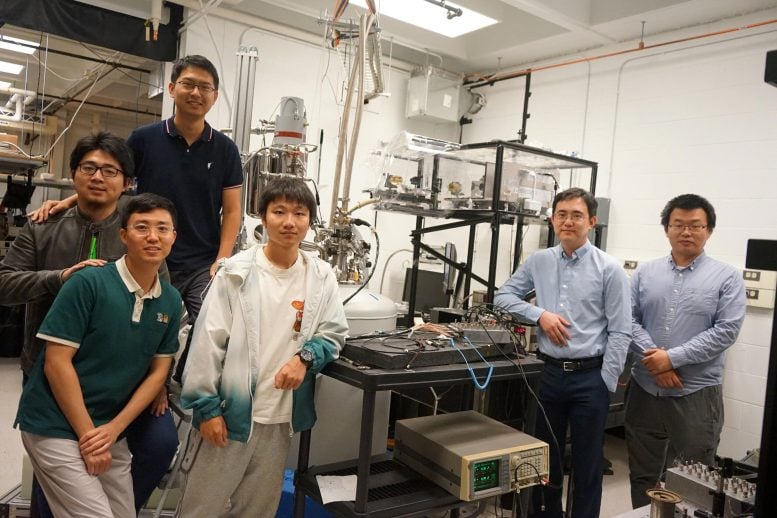By

Artist’s rendering of a recently discovered highway for electrons that can appear in rhombohedral graphene. “We have found a goldmine and every scoop reveals something new,” says Long Ju, an assistant professor at MIT. Credit: Sampson Wilcox/Electronics Research Laboratory

Six of the MIT physicists who created a five-lane superhighway for electrons are (from left) graduate students Jixiang Yang, Junseok Seo, and Tonghang Han; visiting undergraduate student Yuxuan Yao; assistant professor Long Ju; and postdoc Zhengguang Lu. Credit: Shenyong Ye
Improving graphene’s electronic channels
As part of the ongoing work, the team reports having created the highway without any magnetic fields.
Tonghang Han, a graduate student in physics at MIT, is co-lead author of the study. “We are not the first to discover this general phenomenon, but we did it in a very different system. And compared to previous systems, ours is simpler and also supports more electronic channels.” Ju explains, “Other materials can only support one flow path at the edge of the material. We suddenly increased it to five.”
The paper’s co-senior authors, who contributed equally to the work, are Zhengguang Lu and Yuxuan Yao. Lu is a postdoctoral fellow in the Materials Research Laboratory. Yao conducted the work as a visiting undergraduate student from Tsinghua University. The other authors are Liang Fu, professor of physics at MIT; Jixiang Yang and Junseok Seo, both graduate students in physics at MIT; Chiho Yoon and Fan Zhang of the University of Texas at Dallas; and Kenji Watanabe and Takashi Taniguchi of the National Institute of Materials Science in Japan.
How it works
Graphite, the main component of pencil lead, is composed of many layers of graphene, a single layer of carbon atoms arranged in hexagons resembling a honeycomb structure. Rhombohedral graphene is composed of five layers of graphene stacked in a specific order that overlap each other.
Ju and his colleagues isolated rhombohedral graphene using a new microscope that Ju built at MIT in 2021 that can quickly and inexpensively determine a variety of important features of a material at scale.
” data-gt-translate-attributes=”({“attribute”:”data-cmtooltip”, “format”:”html”})” tabindex=”0″ role=”link”>nanoscaleThe five-layer stacked rhombohedral graphene is only a few billionths of a meter thick.
In the current work, the team modified the original system by adding a layer of tungsten disulfide (WS2). “The interaction between the WS2 and the five-layer rhombohedral graphene gave rise to this five-lane superhighway that operates at zero magnetic field,” says Ju.
Comparison with superconductivity
The phenomenon discovered by the Ju group in rhombohedral graphene, which allows electrons to move without resistance in a zero magnetic field, is known as the anomalous quantum Hall effect. Most people are more familiar with superconductivity, a completely different phenomenon that does the same thing but occurs in very different materials.
Ju notes that although superconductors were discovered in the 1910s, it took nearly 100 years of research to make the system work at the higher temperatures needed for applications. “And the world record is still well below room temperature,” he notes.
Similarly, the rhombohedral graphene highway currently operates at around 2 kelvins, or -456 degrees.
” data-gt-translate-attributes=”({“attribute”:”data-cmtooltip”, “format”:”html”})” tabindex=”0″ role=”link”>Fahrenheit. “It will take a lot of effort to raise the temperature, but as physicists, our job is to provide information; a different way of doing this (phenomenon),” Ju says.
Consequences and future prospects
The findings involving rhombohedral graphene are the result of painstaking research whose effectiveness was not guaranteed. “We tried many recipes for several months,” Han says, “so it was very exciting when we cooled the system to a very low temperature and[a five-lane highway operating at zero magnetic field]appeared.”
Ju says: “It’s very exciting to be the first to discover a phenomenon in a new system, especially in a material we discovered. »
Reference: “Large quantum anomalous Hall effect in near-spin-orbit rhombohedral graphene” by Tonghang Han, Zhengguang Lu, Yuxuan Yao, Jixiang Yang, Junseok Seo, Chiho Yoon, Kenji Watanabe, Takashi Taniguchi, Liang Fu, Fan Zhang and Long Ju, May 9, 2024, Science.
DOI: 10.1126/science.adk9749
This work was supported by a Sloan Fellowship; the United States National Science Foundation; the U.S. Office of the Under Secretary of Defense for Research and Engineering; the Japanese Society for the Promotion of Science KAKENHI; and the World Premier International Research Initiative of Japan.